BMW R 1300 GS Pure Review
Motorcycle Test by Wayne Vickers – Images RbMotoLens
BMW is not the type to rest on its laurels. The ‘GS’, the original large-capacity adventure bike, the bike that arguably all other big adventure bikes are measured against, is still near the top of the mountain it built. Perhaps right at the top in some eyes – and it’s hard to argue against that position.

For 2024, the GS could have simply received incremental tweaks and refinements to keep everyone else honest. But, no. Team Motorrad decided to give it a pretty much top-down redesign. It’s a markedly different bike. It’s smaller, lighter, has more capacity, and with that, more power and torque. It’s a new engine and gearbox, both of which are significantly lighter. The suspension has been substantially redesigned and the electronics revised. It is, essentially, a new bike. So, lots to look at.

And I can tell you it is mostly a very good thing. Mostly. But there is one area that has a big question mark over it (or at least the bike I tested did). We’ll get to that.
Most of the things I wanted changed from the previous model were addressed. Being smaller and lighter, for a start, is a massive move in the right direction. It’s down a whopping 12kg over the last model and sits at 237kg fully fuelled. That weight drop, combined with its new dimensions, has it feeling noticeably more nimble and usable. Ergos feel great—it still feels like a GS. And the switch-gear and dash all still look familiar.
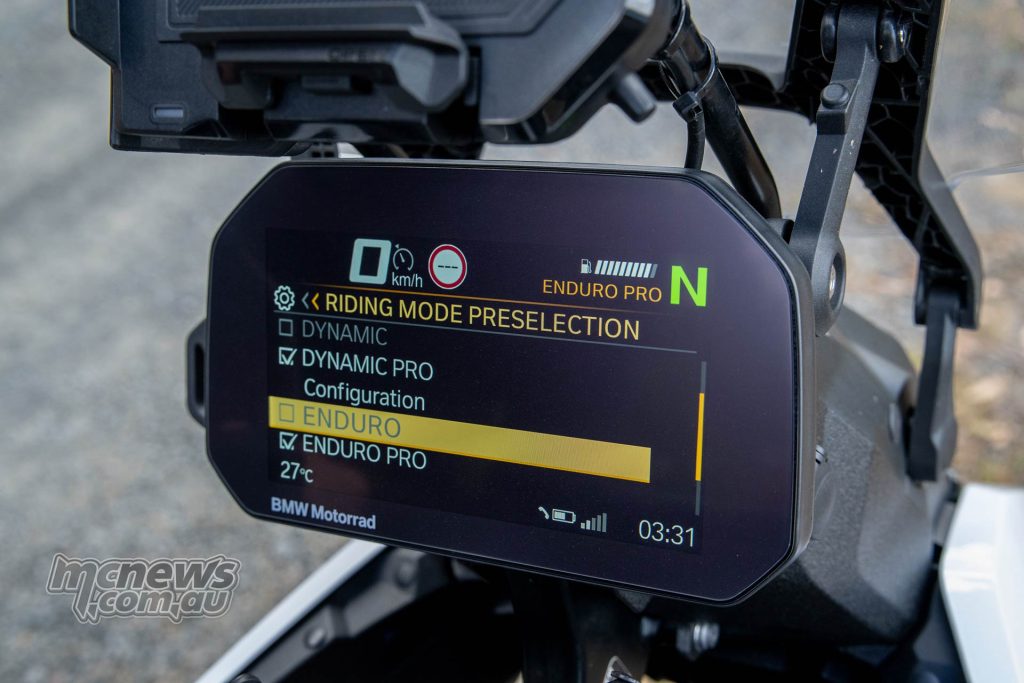
One flipside of those new dimensions is that I’m not sure if the pillion is as well-catered for, which might be an issue for some. The GS has always been one of the great two-up riding prospects. Roomy and comfy with mountains of torque to handle the extra load. So I do hope BMW hasn’t sacrificed that aspect. Personally, I do not care for pillions. The quickest way to ruin a bike ride, in my opinion, but not everyone shares that mindset.
The other area I wanted improved was the progressiveness of the suspension. In particular, the front-end. I felt the old one fell too far through the top of the stroke too quickly.

The new front-end? What a revelation. One of the nicest, in fact probably the nicest, funky telelever front-end I’ve had the pleasure of sampling. At both slow and fast speeds, it instils masses of confidence. There’s heaps of feel and feedback. At slow speeds, it’s supple and smooth; wick it up, and it firms up automagically. The harder you tip into a corner on the road, the better it feels. Amazing.

And then you go to test the anchors. You can pretty much squeeze those bad boys as hard as you dare from high speeds and it just… pulls up. No fuss, no issue. That front doesn’t seem to dive at all in that scenario. The first time you do it you’re left with a ‘Did that just happen?’ kinda feeling. Those stoppers are BMW-branded Brembos, by the way. And they do Brembo things very nicely.

So the handling updates are a big hit. I added one step of firmness to both the Dynamic Pro and the Enduro Pro suspension damping settings and was as happy as a clam.

While we’re talking electronics, other than tweaks, the major new feature on the dash is a sport view that shows live telemetry as some other bikes do. It also records your highest scores!

The other introduction on the 1300 is a ‘Hamburger’ button on the left switch-block that allows for quick toggles of traction control, damping, and heated grips, via a second toggle switch. Sounds great in theory, but somewhat wanting in practice. Damping and TC for instance – you only get the ability to toggle between two choices via that method, as opposed to several if you dive into the menu proper. And I just don’t understand why. It’s just frustrating. I know they can be tweaked in finer increments if I dive into the menu and tap a dozen or more options to get there. Why not surface those options in that hamburger menu?
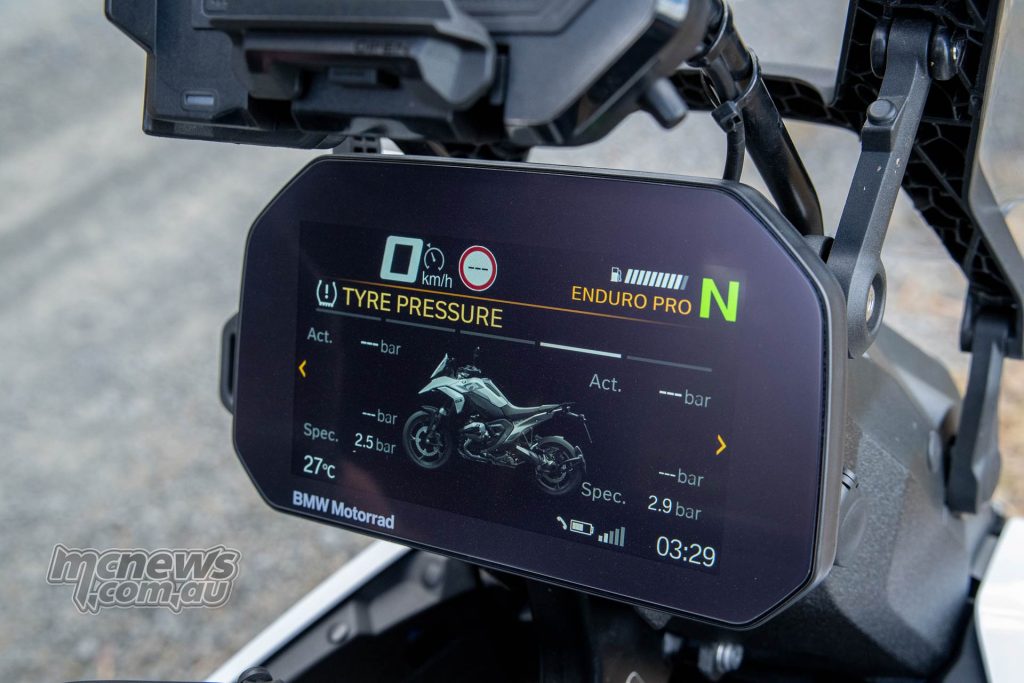
Visually, I didn’t mind the recent generation’s styling, which was always on the butch and purposeful side of things, but was maybe a little busy. By contrast, the new design is much simpler and more svelte, with some terrific surfacing and attention to detail. I’m a fan. Big fan. It seems far more polished and well-executed.

Much like on the big R18, I like the ‘breast plate’ on the front of the boxer engine that serves as a mudguard of sorts – and the relatively easy-to-clean design of various components. The exception is under the front guard, which seems unnecessarily exposed and ready for dirt, even if it does have a lower front-hugger to help stop dirt flicking up.

The screen is adjustable for two positions and can be done on the go easily enough. I felt some buffeting at highway speeds in the upper position, which is unusual for me. When in the lower position, the optional phone cradle sits up in the breeze and would be exposed to the elements, which seemed a bit odd. But I’m sure there will be a plethora of screen options to keep everyone happy, so that’s not a biggie.

The other thing I was hoping for was more refinement in terms of engine noise. Unfortunately, that area seems to have worsened compared to the last model. I’m a big believer that the right symphony of mechanical noises adds immensely to the character of the bike. I’m talking intake, exhaust, vibrations, actuations, gear-shifts – all adding to the aural drama.
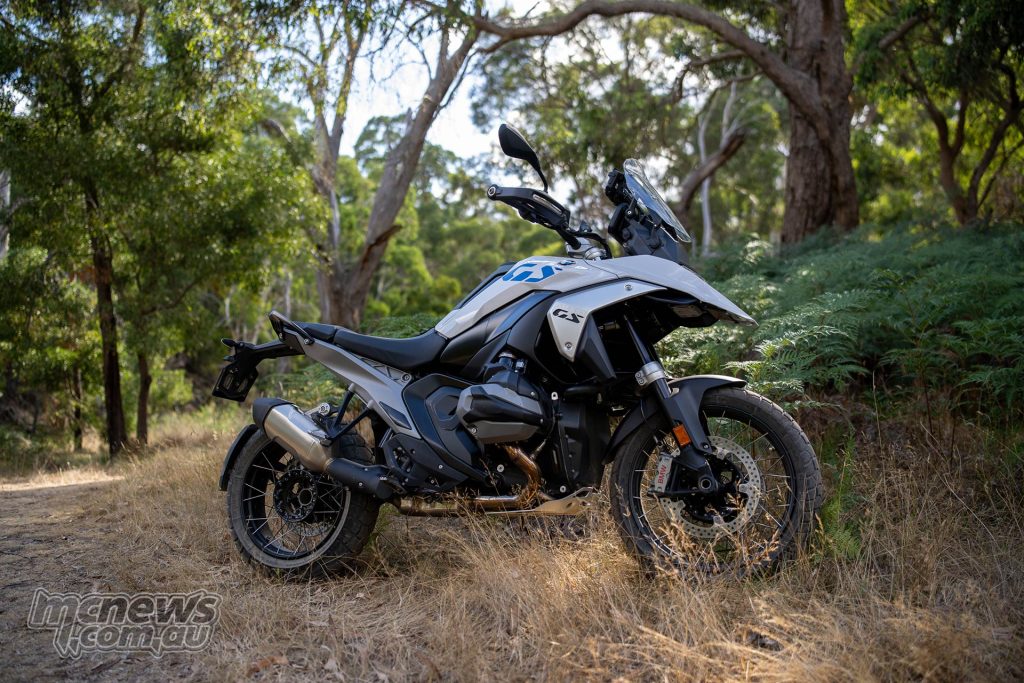
The 1300, to my ears, is loud and clattery, at least in this particular example anyway, especially at idle. Maybe it’s an acquired taste I’m yet to develop. Cue the hate mail in 3, 2, 1… It’s only an opinion people, calm down.

Out on the highway, and once you get up past third gear and throw some wind noise in, you don’t notice it so much. But at a standstill, commuting and filtering among cars, it isn’t exactly an engineering song of joy. Let’s leave it at that…
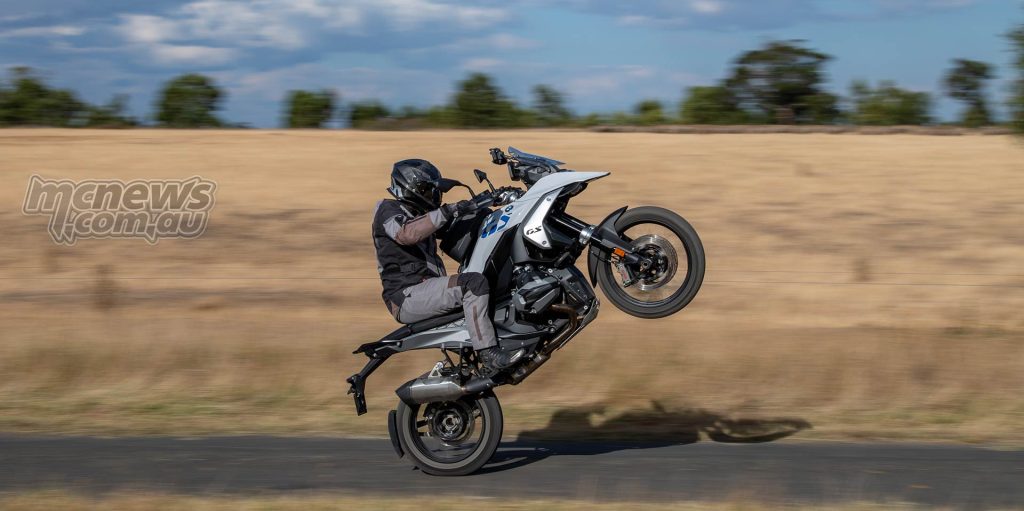
How the engine performs though, is another positive point. Obviously up in capacity with more power and torque than the outgoing model. The old engine was already a stump-puller, and it’s now so damn strong I’m honestly questioning the need for the extra torque. It has gargantuan amounts of it. A whole 149Nm. More than the new KTM Superduke R, in fact. Think third-gear wheelies without the clutch… easily. Do you need that much in an adventure bike? Am I losing my mind? Maybe. It’s bloody impressive regardless.
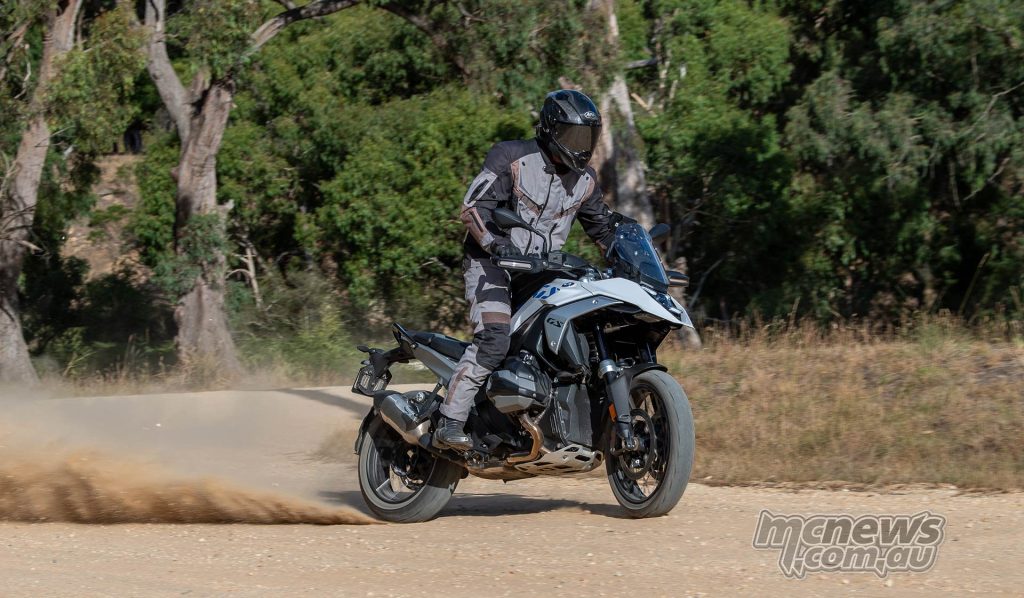
Usable too. The fueling is pretty bang on and it just pulls from as low as 2-2500 rpm. Once you get it up around 4000, it really starts to come into its own, smooths out a little further, and it’s go time. Make no mistake – this thing is a jet. BMW’s most powerful boxer ever at 145 hp.
But it’s that bottom-end hump that’s so impressive. You can cruise along and just use the effortless grunt and short-shift away. Or… you could. If it wasn’t for the Achilles heel I found on this particular example of the new bike.
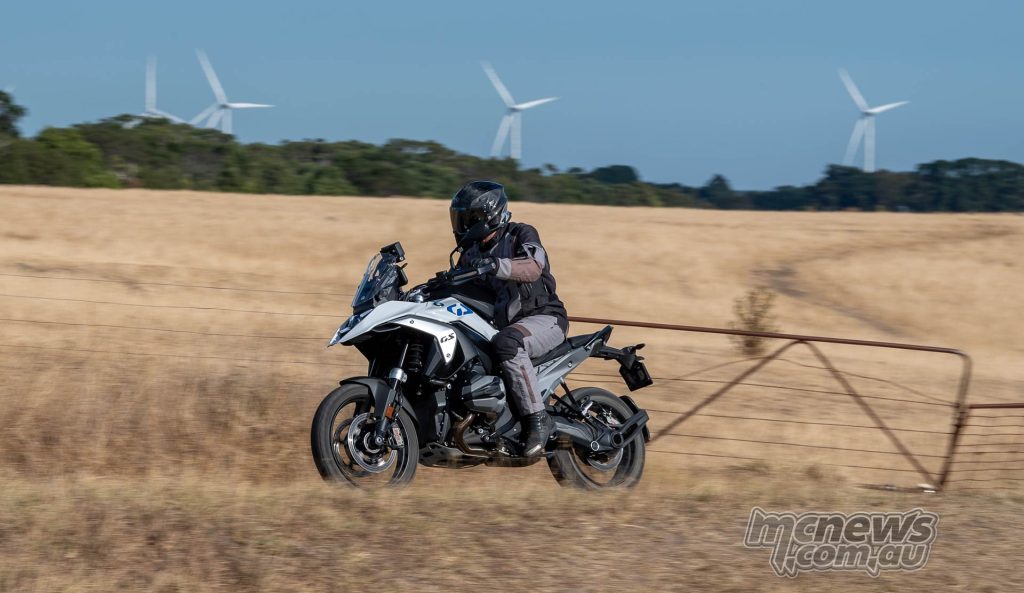
Now, I don’t know yet if it was this bike in particular, or if it’s a problem across the board. We’ll find out when I test the Trophy variant in a week or two. But the new gearbox that’s now sitting under the engine instead of behind it (which has enabled all the packaging and handling tweaks), in our test bike has some fairly serious issues. Most notably in the lower three cogs.
It’s not so bad if you’re out on your own and going at a decent pace in terms of acceleration, but if you are in slow commuter traffic, or filtering along at part throttle, the lower three gears are very clunky. The quick-shifter is not happy operating at part throttle in the lower three gears and was jerky to the point of beyond frustration – particularly when the rest of the bike is so good.

I resorted to clutching it, and even then the shifts were clunky. And more than once, while stopped at lights, it refused to find neutral. Then when it was time to go back into first, it was a shuddering and not-particularly-mechanically-sympathetic clunk.
Time will tell if it was this bike as an outlier. But it was bad enough that if you wanted to include commuting amongst slow traffic in your regular usage on this bike I’d be seriously questioning it. I did also see some oil weepage from the shaft drive too – maybe this press bike had been flogged mercilessly across the desert before it got to me? Possible. Not sure. But it only had five thousand kays or thereabouts on it when I picked it up.

So, in the end, I’m conflicted here. There is a whole lot to love about the new 1300 GS: that front-end, the updated ergos, reduced weight and improved styling. But then there is the gearbox question mark on this bike that needs to be resolved. And I’d like to see further tweaks to that hamburger toggle set-up.
Am I being critical? You bet I am. This is a BMW, after all. It’s a thirty-plus thousand dollar motorcycle by the time you tick some boxes. And remember that this is the same company that brings us the bike I chose as my bike of the year last year, the M1000R (with the best gearbox and quick-shifter set-up I’ve ever ridden). I, and no doubt BMW fans everywhere, have high expectations.
Hopefully, this one was an outlier.

I like the new R 1300 GS Pure because:
- That front-end is a major improvement, just brilliant
- Less weight and smaller dimensions = a more usable machine
- That engine has planet-turning levels of torque. What a tractor
I’d like the new R 1300 GS Pure more if:
- That clunky-jerky gearbox issue. That’s a biggie
- Can the hamburger/toggle setup include the finer increments of adjustment please?
- I’d look at a different screen shape, I think too

| BMW R 1300 GS Pure Specifications | |
| Engine | 1,300 cc Air/liquid-cooled four-stroke flat twin engine with double overhead and chain driven camshafts (BMW ShiftCam) and balance gear wheels |
| Compression Ratio | 13.3 : 1 |
| Power | `107 kW (145 hp) at 7,750 rpm |
| Torque | 149 Nm at 6,500 rpm |
| Emission control | Closed-loop 3-way catalytic converter |
| Bore x stroke | 106.5 mm x 73 mm |
| Compression ratio | 13.3:1 |
| Mixture control | Electronic intake pipe injection |
| Exhaust emission standards | EU 5 |
| Maximum speed | over 200 km/h |
| Fuel consumption per 100 km based on WMTC | 4.8 l |
| CO2 emission based on WMTC | 110 g/km |
| Fuel type | Super unleaded, 95 ROZ/RON; adaptive fuel quality regulation, 91-98 ROZ/RON |
| Alternator | `Three-phase alternator with 650 W (nominal power) |
| Battery | 12 V / 10 Ah, maintenance-free Lithium-ion battery |
| Clutch | Wet clutch, anti-hopping clutch, hydraulically operated |
| Gearbox | Claw-shifted 6-speed gearbox |
| Drive | Cardan |
| Traction control | BMW Motorrad DTC |
| Frame | Two-part frame concept consisting of main frame and rear frame bolted to it, co-supporting engine |
| Front-wheel location/suspension | BMW Motorrad EVO-Telelever, handlebar tilting decoupled via flex element, central shock absorber |
| Rear wheel location/suspension | BMW Motorrad EVO-Paralever, cast aluminium single-sided swingarm, transversal connected swing arm bearings, central WAD spring strut, spring preload fully adjustable |
| Suspension travel, front / rear | 190 mm / 200 mm |
| Wheelbase | 1,518 mm |
| Castor | 112 mm |
| Steering head angle | 63.8 ° |
| Wheels | Aluminium cast wheels |
| Rim, front | 3.00 x 19“ |
| Rim, rear | 4.50 x 17“ |
| Tyre, front | 120/70 R19 |
| Tyre, rear | 170/60 R17 |
| Brake, front | Twin disc brake, semi-floating brake discs, diameter 310 mm, 4-piston radial brake caliper |
| Brake, rear | Single disc brake, diameter 285 mm, 2-piston floating caliper |
| ABS | BMW Motorrad Full Integral ABS Pro (lean angle optimized) |
| Seat height at unladen weight | 850 mm |
| Inner leg curve at unladen weight | 1,900 mm |
| Usable tank volume | 19 l |
| Reserve | Approx. 4 l |
| Length | 2,212 mm (over splash guard) |
| Height | 1,406 mm (above windshield) |
| Width | 1,000 mm (over hand guard) |
| Unladen weight, road ready, fully fuelled | 237 kg |
| Permitted total weight | 465 kg |
| Payload (with standard equipment) | 228 kg |
| Included as standard |
| Dynamic Package (DSA, Gear Shift Assistant Pro, Riding Modes Pro |
| Sports Brake |
| Preparation for GPS Device |
| Black Cross Spoke Wheels |
| Riders Seat Height (850mm) |
| Options |
| Gold Cross Spoke Wheels: No cost option |
BMW R 1300 GS Pure Review Images






















































































